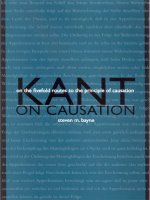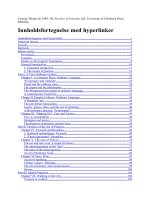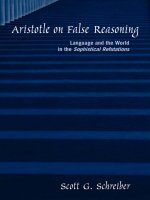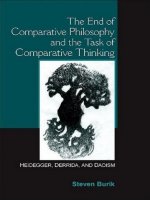university of texas press thelma & louise live the cultural afterlife of an american film nov 2007
Bạn đang xem bản rút gọn của tài liệu. Xem và tải ngay bản đầy đủ của tài liệu tại đây (4.74 MB, 241 trang )
THELMA & LOUISE LIVE!
THELMA
LOUISE
&
LIVE!
Edited by BERNIE COOK
UNIVERSITY OF TEXAS PRESS AUSTIN
The Cultural Afterlife
of an American Film
Copyright © 2007 by the University of Texas Press
All rights reserved
Printed in the United States of America
First edition, 2007
Requests for permission to reproduce material from this work
should be sent to:
Permissions
University of Texas Press
P.O. Box 7819
Austin, TX 78713-7819
www.utexas.edu/utpress/about/bpermission.html
∞
The paper used in this book meets the minimum requirements
of ansi/niso z39.48-1992 (r1997) (Permanence of Paper).
Library of Congress Cataloging-in-Publication Data
Thelma & Louise live! : the cultural afterlife of an American film / edited by
Bernie Cook. — 1st ed.
p. cm.
Includes bibliographical references and index.
isbn 978-0-292-71465-6 (cloth : alk. paper) — isbn 978-0-292-71466-3
(pbk. : alk. paper)
1. Thelma & Louise (Motion picture) I. Cook, Bernie, 1968– II. Title:
Thelma & Louise live!
pn1997.t427t44 2007
791.43'72—dc22 2007005589
For Jen, Lucy, and Emmett
THIS PAGE INTENTIONALLY LEFT BLANK
Acknowledgments ix
Introduction 1
“I Can See Clearly Now”
Bernie Cook
“Something’s Crossed Over in Me” 7
New Ways of Seeing Thelma & Louise
Bernie Cook
Getting Hysterical 43
Thelma & Louise and Laughter
Victoria Sturtevant
Hearing Thelma & Louise 65
Active Reading of the Hybrid Pop Score
Claudia Gorbman
Interplaying Identities 91
Acting and the Building Blocks of Character in Thelma & Louise
Susan Knobloch
An Outlaw-Couple-on-the-Run Film for the 1990s 122
J. David Slocum
“What All the Fuss Is About” 146
Making Brad Pitt in Thelma & Louise
Cynthia Fuchs
Interview with Callie Khouri, December 19, 2002 168
Bernie Cook
CONTENTS
1
2
3
4
5
6
7
viii Contents
APPENDIX I Commentaries 191
Toxic Feminism on the Big Screen | John Leo 191
Gender Bender | Richard Schickel 193
Is This What Feminism Is All About? | Margaret Carlson 201
APPENDIX II Filmographies 205
Callie Khouri 205
Ridley Scott 206
Selected Bibliography 213
Contributors 217
Index 219
ix
This book would not have been possible without the support and encour-
agement of Andy Horton of the University of Oklahoma, who commis-
sioned an earlier version of this anthology and helped it find a home at the
University of Texas Press. I also thank Callie Khouri for discussing the gen-
esis of Thelma & Louise and for agreeing to be interviewed for this volume.
I thank my contributors for sharing their insights into Thelma & Louise
and for their patient support of this project. I thank editor Jim Burr and
the sta≠ at the University of Texas Press for their enthusiasm and profes-
sionalism.
At Georgetown University, I have benefited from the generosity of many
colleagues, especially John Glavin, Steve Wurtzler, and Lalitha Gopalan. I
thank Jane McAuli≠e, Dean of Georgetown College, and my colleagues in
the Dean’s O∞ce for their interest in the project and for their support of my
scholarship. Gavin Ho≠mann served as my research assistant on the an-
thology, discovering critical evidence of audience response to the film, cap-
turing and preparing most of the illustrations, and continuing to work even
after the end of his assistantship.
Finally, I thank my family. My parents, Bernard and Rosemary, and my
sister, Jennifer, nurtured my love of film from the beginning. My wife, Jen,
is my best editor and my favorite filmgoing companion, as in 1991 when to-
gether we saw Thelma & Louise in its initial theatrical release. My children,
Lucy and Emmett, inspire everything I do.
ACKNOWLEDGMENTS
THIS PAGE INTENTIONALLY LEFT BLANK
THELMA & LOUISE LIVE!
THIS PAGE INTENTIONALLY LEFT BLANK
1
“Thelma & Louise Live”
Fifteen years after its initial release, Thelma & Louise (1991) remains cul-
turally resonant and politically potent. A bumper sticker still in circulation
in 2006 proclaims, “Thelma & Louise Live,” asserting that the characters
survive in cultural memory despite their textual demise and, further, that
the film remains a dynamic intertext, generating new meanings as new
viewers encounter it in new contexts. As this anthology argues, the film is
profoundly polyphonic, both textually and contextually, o≠ering viewers
ways of crossing gender and identity, of gaining insight into the interrela-
tions of gender and violence. Thelma & Louise’s legacies are multiple and
complex, extending into production, promotion, reception, and also “real-
world” discourse on women, men, violence, and power.
Although the characters may not have survived their final flight, Thelma
& Louise lives on in unusual places. Extracinematically, Thelma & Louise
has been used as a statement of female empowerment and self-assertion
and also as a warning of the perceived dangers of female access to violence.
In 2001, two female fans of professional football at a Baltimore Ravens
NFL game wore purple jerseys with “Thelma” and “Louise” embroidered on
their backs. The large majority of fans at the game were male, many of
whom wore jerseys with the names of favorite players, such as linebacker
Ray Lewis, renowned for his violent tackles on the field of play and notori-
ous for his acquittal from charges that he murdered three men after a Super
Bowl party. Professional football exemplifies the American tendency to nor-
malize masculine violence into sport, legal permissiveness, and invisible
systems of control of gendered bodies. Thus, within the context of football
as symbolic and literal arena of male violence, the two female fans’ choice of
“Thelma” and “Louise” resonates with political meaning, as well as personal
Bernie Cook
INTRODUCTION “I Can See Clearly Now”
2 Bernie Cook
significance. These women used the film to assert identification with strong
female characters who accessed violence as a tool for survival within a patri-
archal society. In this world of normalized male violence, the original re-
lease of Thelma & Louise was extremely controversial, asserting that vio-
lent agency was not exclusively a male privilege. By representing women as
both victims and agents of violence, Thelma & Louise broke radical new
ground in mainstream American representation, profoundly threatening
masculinist critics who objected to its breach of the norm of violence as
male privilege.
“I Can See Clearly Now”
Thelma & Louise also lives on through scholarship and research. By late
1991, both Film Quarterly and Cineaste published scholarly fora featuring
short reflections on the film’s meaning and significance, including articles
by Carol Clover, Marsha Kinder, and Elayne Rapping, among others. In
1993, Film Theory Goes to the Movies, an anthology of theoretically in-
flected criticism of contemporary film, featured essays on Thelma & Louise
by Cathy Griggers and Sharon Willis. In 2000, the British Film Institute
published Marita Sturken’s monograph on Thelma & Louise as an edition
of its “Film Classics” series. Outside of film studies, in Critical Studies in
Mass Communication (1999), Brenda Cooper published a study of gen-
dered reception of Thelma & Louise in which she employed the methodol-
ogy of relevance theory. In 2001, Tiina Vares published a study of women’s
Thelma and Louise “keep going” over the edge of the Grand Canyon. Frame
capture.
“I Can See Clearly Now” 3
reception of Thelma & Louise in Feminist Media Studies. Thelma & Louise
has received significant, but hardly exhaustive, scholarly attention.
This volume seeks to complement existing scholarship on Thelma &
Louise, to break new ground in understandings of the film, and to pioneer
productive new critical and theoretical approaches in film studies. The con-
tributors approach the film from di≠erent locations, employing diverse
meth od ologies to understand the film and its impact. The chapters are
linked by a shared concern with the film’s social meanings, meanings sought
through attention to gender as performance and to audience response to
performance of the relations between gender, identity, and power. The es-
says in this anthology propose to see Thelma & Louise clearly, in new ways.
In the first chapter, I argue that Thelma & Louise provided female and
male viewers with possibilities of seeing film in new ways. Through analysis
of the film’s production, promotion, and reception, I contend that Thelma
& Louise provided textual opportunities for both male and female viewers
to engage female experiences of gendered violence from within a series of
contexts. By examining the responses of historical viewers to Thelma &
Louise, I suggest that film reception itself is fluid and complex and that
viewers have opportunities to learn about gendered experience through
identification and connection, to see familiar experience from new perspec-
tives, to learn and to change.
Some viewers found Thelma & Louise challenging because of its mixture
of tones. Victoria Sturtevant examines Thelma & Louise through the lens of
comedy theory, seeking to understand the film’s radical combination of
laughter and violence. Sturtevant argues that the film’s emphasis on female
laughter provided women viewers with opportunities to experience release
from social containment while simultaneously threatening some male
viewers with its potential to disrupt patriarchal containment. Whereas
Sturtevant employs performance theory to understand the comedic ele-
ments of Thelma & Louise, Susan Knobloch seeks to theorize performance
in the film through careful attention to acting as a specific cinematic dis-
course. Through close analysis of ways in which actors signify via physical
action, Knobloch argues that Thelma and Louise, as performed by Geena
Davis and Susan Sarandon, demonstrate the possibilities of multivoiced,
multibodied “composite subjects.” Knobloch argues that, at the level of per-
formance, Thelma & Louise articulates new opportunities for fluid identi-
ties within, if not across, gender.
4 Bernie Cook
Thelma & Louise appealed to many viewers because of its exuberant,
commentative sound track and its recasting of generic expectations. Shar-
ing Knobloch’s attention to the details of film signification, Claudia Gorb-
man analyzes sound and music in Thelma & Louise. Gorbman argues that
Thelma & Louise featured a hybrid score combining Hans Zimmer’s instru-
mental score with eighteen pop songs, resulting in a complex intertextual
soundscape that profoundly shaped the film’s possible meanings. Through a
series of case studies analyzing the use of specific pop songs in the film, in-
cluding Marianne Faithfull’s version of “The Ballad of Lucy Jordan” and
Johnny Nash’s “I Can See Clearly Now,” Gorbman proposes that the film’s
hybrid score invites viewers to engage in more active readings, enabling
complex possibilities for identification on both aural and visual registers.
When MGM/UA released Thelma & Louise in 1991, the studio produced
promotional trailers that alternately marketed the film as a road movie, a
buddy movie, a female friendship film/melodrama, a comedy, and an action
movie. David Slocum engages the film’s complex generic status, focusing
upon its dual status as a road movie and a lovers-on-the-run movie. Slocum
produces a social history of the road film, arguing that the genre’s consis-
tent social concerns have been with violence, containment, critique of dom-
inant orders, and the possibilities and limits of freedom. Slocum links Thel -
ma & Louise to Bonnie and Clyde (1967), both road and run films featuring
outlaw “couples.” Slocum reads Thelma & Louise’s cultural politics at the
beginning of the 1990s against Bonnie and Clyde’s cultural politics at the
end of the 1960s, understanding Thelma & Louise as counter to Reagan-
era entertainment by restaging a version of 1960s critical liberalism.
While helping the careers of Sarandon and Davis, Thelma & Louise in-
troduced audiences to another star, Brad Pitt. Cindy Fuchs examines the
meaning of the making of Brad Pitt, first by Thelma & Louise and later by
the accumulation of his film roles and extracinematic exploits. Fuchs uses
her analysis of the formation of Pitt’s star image to explore a historical shift
in thinking about masculinity, changing structures of sexualization and ob-
jectification, and female agency and volition.
In addition to the six essays, this anthology includes a new interview
with screenwriter Callie Khouri, who won an Academy Award for writing
Thelma & Louise, her first screenplay. In this interview, Khouri discusses
the film’s production, addressing director Ridley Scott’s choices in adapting
her screenplay. She talks about the intertextual influences that shaped her
“I Can See Clearly Now” 5
creative process and about the film’s reception and afterlife. As a screen-
writer and director, Khouri shares important insights about the gender pol-
itics of film production in Los Angeles and about the film’s relations to
feminism.
In a final section, this volume includes three commentaries written
about Thelma & Louise in 1991. Writing in U.S. News & World Report, John
Leo o≠ered the strongest attack on the film, condemning Thelma & Louise
as “toxic feminism on the big screen” (June 10, 1991). Free from the re-
viewer’s responsibility to engage the film’s specificity, Leo instead repre-
sented those most threatened by the film, men and (some) women who un-
derstood violent agency as a male prerogative. Leo’s commentary fed the
controversy over the film, and, in response, Time published a cover story,
entitled “Why Thelma and Louise Strike a Nerve” (June 24, 1991). In a piece
entitled “Gender Bender,” Richard Schickel reviews journalistic response to
the film during its first month of release, o≠ering a valuable summary of as-
pects of the film’s initial reception. In the same issue, Margaret Carlson cri-
tiques the film for fatalism, while also appreciating the film’s virtues. Carl-
son articulates another important response to the film, ambivalence by
female viewers about the ending. From within the heat of a raging contro-
versy, these critics and commentators may not have seen the film as clearly
as scholars working from the remove of a decade and a half. Nevertheless,
these articles provide evidence of the strong and significant response to
Thelma & Louise at its time of release and testify to the film’s importance.
Thelma and Louise clasp hands, reaching a decision not to surrender. Frame
capture.
6 Bernie Cook
This anthology seeks to understand the social meanings of that response,
helping the film to live on through scholarship, teaching, and spirited dis-
cussion.
Bibliography
Carlson, Margaret. “Is This What Feminism Is All About?” Time, June 24, 1991, 57.
Cooper, Barbara. “The Relevancy and Gender Identity in Spectators’ Interpretations of
Thelma & Louise.” Critical Studies in Mass Communication 16 (1999): 20–41.
Clover, Carol. “Crossing Over.” Film Quarterly 45:2 (Winter 1991–1992): 22.
Griggers, Cathy. “Thelma and Louise and the Cultural Generation of the New Butch-
Femme.” In Film Theory Goes to the Movies, ed. Jim Collins, Hilary Radner, and
Ava Preacher Collins. New York: Routledge, 1993, 129–141.
Kinder, Marsha. “Thelma & Louise and Messidor as Feminist Road Movies.” Film
Quarterly 45:2 (Winter 1991–1992): 30–31.
Leo, John. “Toxic Feminism on the Big Screen.” U.S. News & World Report, June 10,
1991, 20.
Rapping, Elayne. “Feminism Gets the Hollywood Treatment.” Cineaste 18:4 (Decem-
ber 1991): 30.
Schickel, Richard. “Gender Bender.” Time, June 24, 1991, 52–56.
Sturken, Marita. Thelma & Louise. London: BFI, 2000.
Vares, Tiina. “Framing ‘Killer Women’ Films: Audience Use of Genre.” Feminist Media
Studies 2:2 (2002): 213–229.
Willis, Sharon. “Hardware and Hardbodies, What Do Women Want?” In Film Theory
Goes to the Movies, ed. Jim Collins, Hilary Radner, and Ava Preacher Collins. New
York: Routledge, 1993, 120–128.
7
“Part of Me, Part of You”
Toward the conclusion of Thelma & Louise, Thelma (Geena Davis) explains
to Louise (Susan Sarandon) that she will not surrender to police, that sur-
render is not an option because of a new sense of self. She explains, “Some-
thing has crossed over in me. I can’t go back.” True to the conventions of the
road movie, Thelma has been changed by her experiences on the road.
Screenwriter Callie Khouri has structured the film to provoke change in
both of her main characters, and at this final juncture both characters have
shifted from initial fixity (imprisonment in rigid, narrow gender and class
roles) to dynamic hybridity: each now incorporates an aspect of the other,
and both women have adopted signs (costume) and postures (bodily com-
portment) associated with male outlaws. Not only have they crossed each
other (Thelma becoming more assertive, Louise less rigid and controlled),
but also they have crossed over the barriers marking conventional gender
roles in American generic cinema. Though decidedly not “free”—the road is
full of peril and threat and containment—the road has enabled them mobil-
ity of identity, a mobility that is confusing but ultimately, crucially, mean-
ingful. Thelma and Louise are willing to die rather than surrender this
hard-won mobility of self.
In this chapter, I argue that Thelma & Louise provides viewers with op-
portunities to embrace a similar mobility through the act of reception. In-
deed, I argue that the film’s social significance (its claim to lasting impor-
tance) is tied to the text’s openness to investment and identification with
the complex, hybrid subjectivities of the two female protagonists. In re-
sponse to critics, both male and female, who lamented the film’s portrayal
Bernie Cook
“SOMETHING’S CROSSED OVER IN ME”
New Ways of Seeing Thelma & Louise
1
8 Bernie Cook
of its male characters, Davis argued that critics who thought the film was
unfair to men were identifying with the wrong characters. Indeed, most
professional critics and pundits assumed that viewers were limited to iden-
tification (at any level, from empathy to fantasy) with characters of the
same gender.
1
Instead, I argue that Thelma & Louise enabled a range of
viewers to access the main character’s mobile subjectivities, to cross over
the divide of gender to more fluid, dynamic possibilities, where female and
male viewers can take up a complex range of positions relative to the social
categories of femininity and masculinity.
Thelma confides in Louise that “something has crossed over” in her. Frame
capture.
Louise agrees that they cannot go back. Frame capture.
“Something’s Crossed Over in Me” 9
“The Most Talked About Film of 1991!”
In a promotional video prepared for video retailers, seeking to attract orders
for Thelma & Louise’s VHS rollout in 1992, MGM/UA proclaimed the film
to be “the most talked about film of 1991.” Reception Theory has long held
that the social meaning of film—the uses made of a film by its audience—is
produced through the encounters between texts and audiences in contexts.
The frequency of these encounters can be di∞cult to measure, but one indi-
cator of engagement between audience and film is box o∞ce. Another im-
portant indicator is press coverage, and a third is discursive controversy.
Thelma & Louise was a box o∞ce hit (relative to expectations) that gener-
ated considerable press coverage, creating sustained discursive controversy.
Film historians often look to budget and box o∞ce figures to assess stu-
dio expectations for a film and extrapolate audience interest. In the case of
Thelma & Louise, budget and box o∞ce figures reveal a complex constella-
tion of expectations (by filmmakers, distributor, and audience) and signifi-
cant interest. Mimi Polk and Ridley Scott produced Thelma & Louise for a
budget of $16.5 million. Screenwriter Callie Khouri had first attempted to
develop the film independently with producer Amanda Temple, seeking
financing of about $1 million. The final cost of Scott and Polk’s production
suggests that the film was budgeted far in excess of an “independent film,”
circa 1991.
2
The average cost of the top thirty grossing films of 1991 was $37
million.
3
Thus, while not an independent film, Thelma & Louise was bud-
geted at less than half of the average, which suggests that MGM/UA execu-
tives did not feel that the film, even with Scott at the helm, had blockbuster
potential. The film received a mid-level budget, befitting a character-driven
film, featuring two female actresses not yet stars, and initially marketed
largely to a female audience.
Despite this narrow vision of the film’s appeal, Thelma & Louise found a
wide audience. In its theatrical release, Thelma & Louise earned $45.4 mil-
lion in U.S. domestic gross income, or nearly three times its production
cost. Although this figure was far less than the $205 earned by Terminator
2: Judgment Day (Tri-Star), the top-grossing film of 1991, Thelma & Louise
nonetheless became one of the top-grossing films of the year, despite sig-
nificantly less promotion than the top films. Moreover, Thelma & Louise’s
surprising success suggests that the film’s appeal, and its impact, exceeded
MGM/UA’s e≠orts to fix the film’s meanings and identify and package the
10 Bernie Cook
film’s audience. It is important to note that the film’s earnings demonstrate
that the film had a wider appeal, attracting multiple audiences and diverse
viewers.
The film also attracted multiple and diverse reviewers. Returning to
MGM/UA’s claim that Thelma & Louise was the “most talked about film of
1991,” the intensity and variety of response to the film in print and other
media suggests more about audience engagement with the film than do box
o∞ce figures. When film scholars discuss “viewer response,” most often they
theorize the possible spectators addressed by a film text or attempt to con-
struct the available schema for interpretation by analyzing popular reviews.
In the case of Thelma & Louise, it is possible to focus upon the significant
critical, journalistic, and scholarly response to the film, but it is also possi-
ble to examine evidence of the responses of actual viewers. For example,
viewer response was captured via the studio’s audience testing, via letters
about individual experiences of the film written to the editors of mass-
circulation magazines such as Time and Newsweek and via Internet fan ac-
tivity, including 14,088 user ratings posted to the Internet Movie Database
(IMDB) website as of February 6, 2004. These discrete viewer responses
occurred within a broader context of sustained critical commentary gener-
ated by a range of journalistic and scholarly writers. In addition to being re-
viewed widely by professional film critics, Thelma & Louise was assessed by
a range of political pundits and was featured on the cover of magazines
from Time to Sight and Sound. Attention to the film extended to scholarly
publications, as both Film Quarterly and Cineaste collected the responses
of a range of scholars into special sections. The film’s social meanings were
made and remade within and between these contexts, generating a compli-
cated and fluid field of discourse.
“Two bitches in a car. I don’t get it.”
To fully appreciate the surprising success of Thelma & Louise, as well as to
understand the unexpectedly heated and extended discursive controversy
over the film, one needs to examine the horizon of expectations generated
by the film’s production, distribution, and reception. The film’s impact was
shaped by its production and promotion, the generic contexts in which it
was produced and consumed, and the extracinematic context of gender pol-
itics in the late 1980s and early 1990s, often referred to as “the gender wars,”
in which any viewer was situated, conscious or not. In The Range of Inter-
“Something’s Crossed Over in Me” 11
pretation and elsewhere, Wolfgang Iser has argued that such contexts, or
horizons, not only define expectations, but also shape the possibilities for
meaning of a cultural text such as a film. Thus, if Thelma & Louise o≠ers
viewers new possibilities for seeing and identifying with female characters
who demonstrate violent agency, the new possibilities are shaped by the
complex constellations of film, context, intertext, and audience. In this
sense, “Thelma & Louise” references this broadest set of incrustations, not
simply the film, but also the film in contexts.
When MGM/UA released a second, deluxe DVD package for Thelma &
Louise in February 2003, the package included a “making of ” documentary
short entitled Thelma & Louise: The Last Journey, a seeming attempt to
close down some of the film’s ambiguity and openness. Produced for Ridley
Scott’s Scott Free Productions, this “documentary” is really another itera-
tion of the film’s promotion, working to define the film’s meanings and im-
portance for future viewers/DVD consumers. It is not surprising that Scott
is featured prominently. Holding a fat cigar throughout his interviews, per-
forming a stereotype of Hollywood masculinity, Scott tells tales about the
di∞culties securing studio financing for the film, tales that invariably locate
him as protagonist and protector of the film. In one such tale, Scott talks
about the failure of a male studio executive to understand the film, a tale in-
tended to locate Scott as a member of the “boys’ club,” but to di≠erentiate
him as especially sensitive and visionary. According to Scott, the unnamed
studio executive complained about the screenplay: “Two bitches in a car. I
don’t get it.”
According to screenwriter Callie Khouri, many in Hollywood did not
“get” her script, failing to see the appeal of a film built around two female
friends on the run from patriarchal authority. The executive’s easy slide
from women to “bitches” suggests that the film’s expressionistic rendering
of a masculine world of phallic threat to women could serve as metaphor for
the entertainment industry’s gender politics. The executive’s casual misog-
yny also suggests a profound misunderstanding of the complexity of audi-
ence response and audience desire. As a male viewer, he seems to say, “I
have no interest in women characters, especially in women characters who
are violent agents.” Such women are a threat that must be contained and re-
jected. The mobility suggested by “car,” hints at the threat as a challenge to
male privilege. This executive does not want to understand the appeal of a
film that allows women degrees of movement and agency. The suggestion of
12 Bernie Cook
anger in his response (“bitches”) also links to the repressive male violence
dramatized in the film. Recall, Harlan (Timothy Carhart), who assaults
Thel ma, and the truck driver (Marco St. John), who harasses the women,
both use “bitches” as a prominent epithet to mark the women’s threat, as
when the truck driver labels the pair “bitches from hell.” Finally, the execu-
tive’s tone of anger and incomprehension presages the response of conser-
vative pundits, mostly male, who attacked the film upon its release as dan-
gerous and threatening.
“Callie Khouri’s Thelma & Louise”
After some convincing by producing partner Mimi Polk, Scott did finally
“get” the film. In two ways: he came to understand the screenplay as appeal-
ing, both to him and potentially to audiences, and he acquired an option on
the screenplay, getting it for his production company. Initially, Scott in-
tended only to produce the film, but after having di∞culty attracting the
right director (apparently, creative talent was not immune to the executive’s
worldview) he considered directing the film himself. Seemingly, such an
Ridley Scott on the set with cigar. Frame capture, Thelma & Louise: The Last
Journey.









